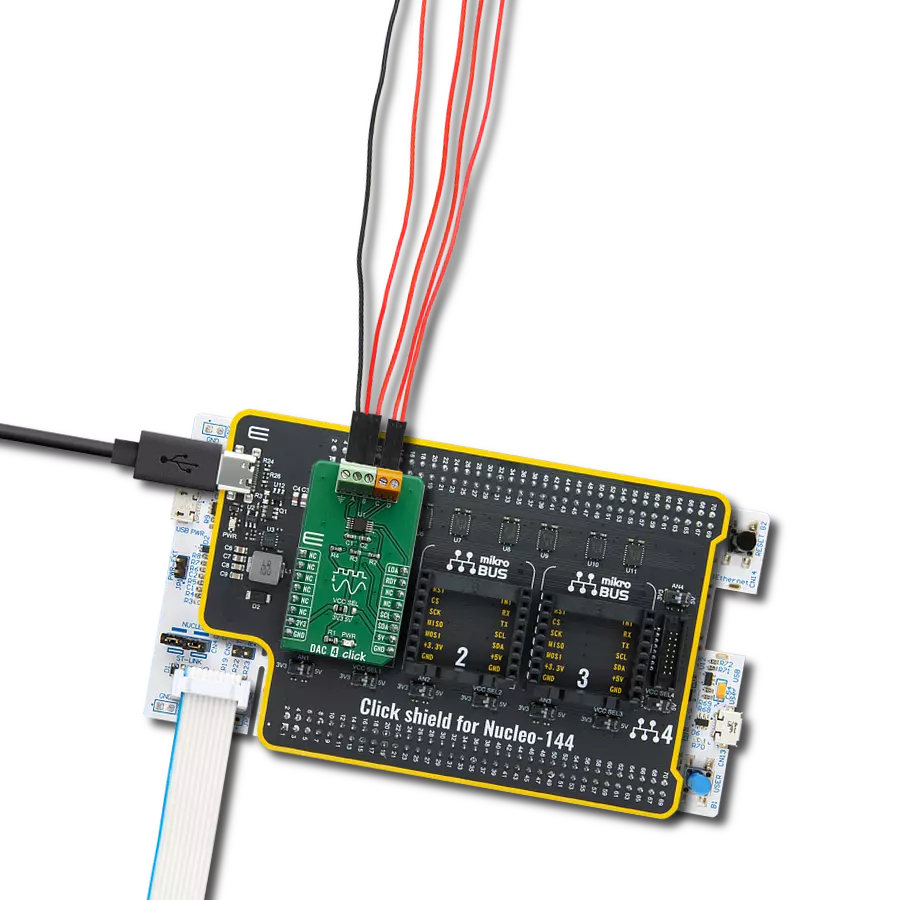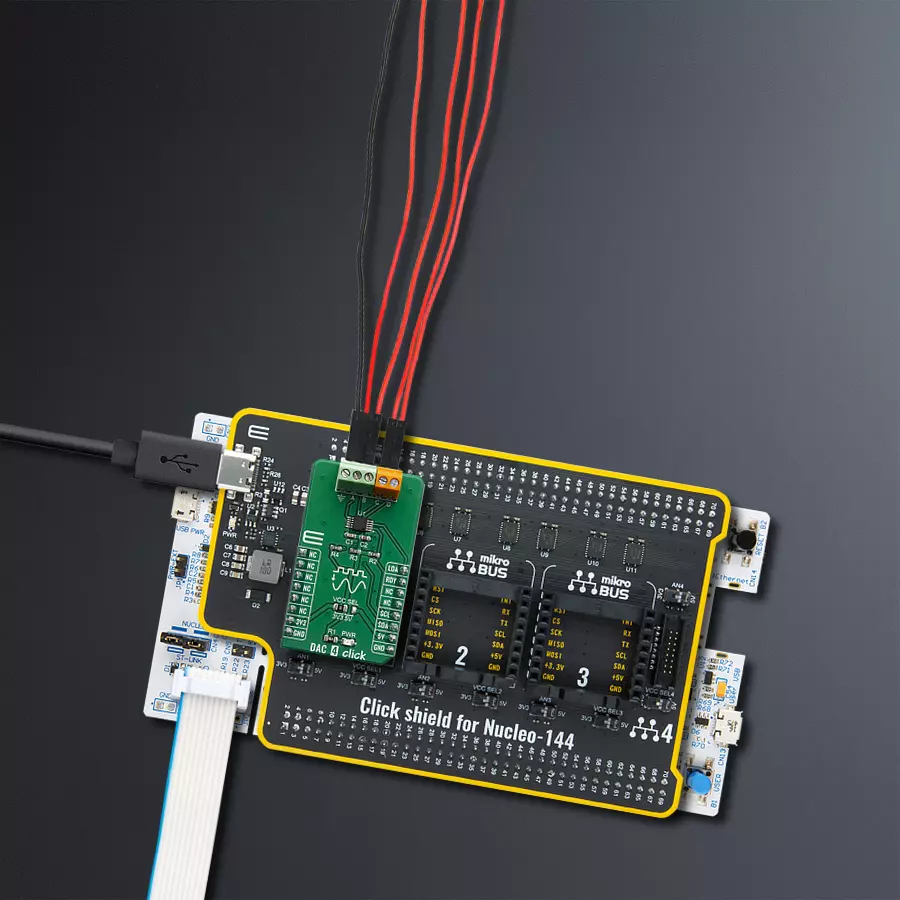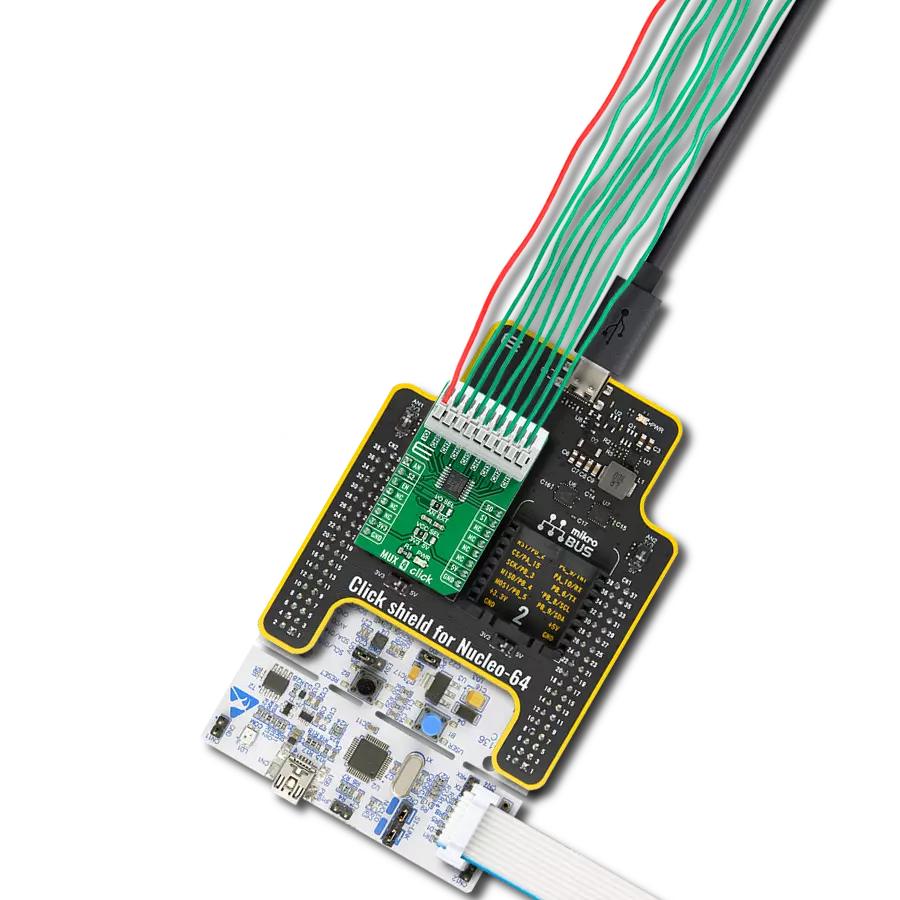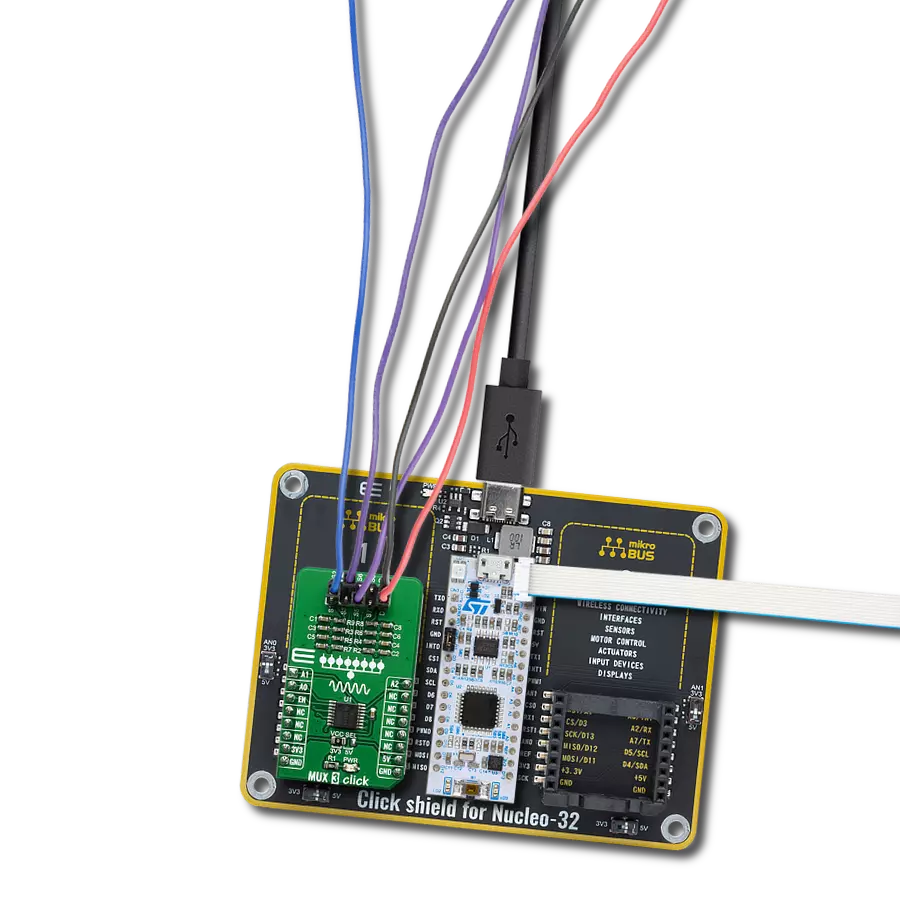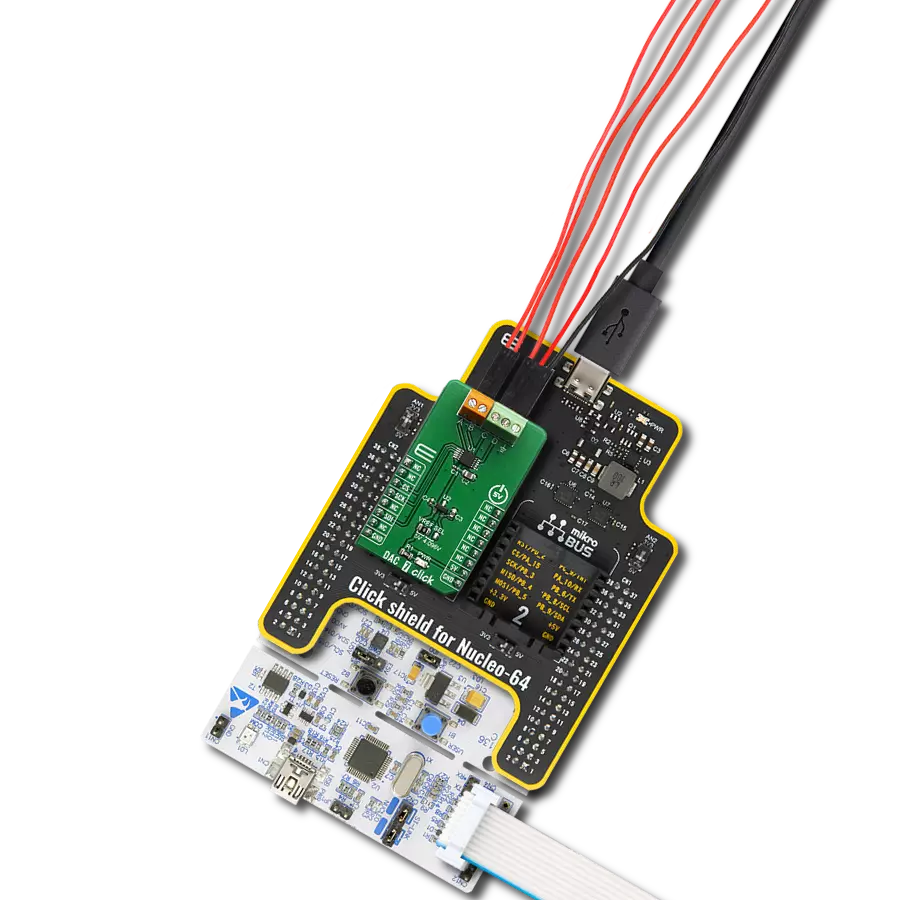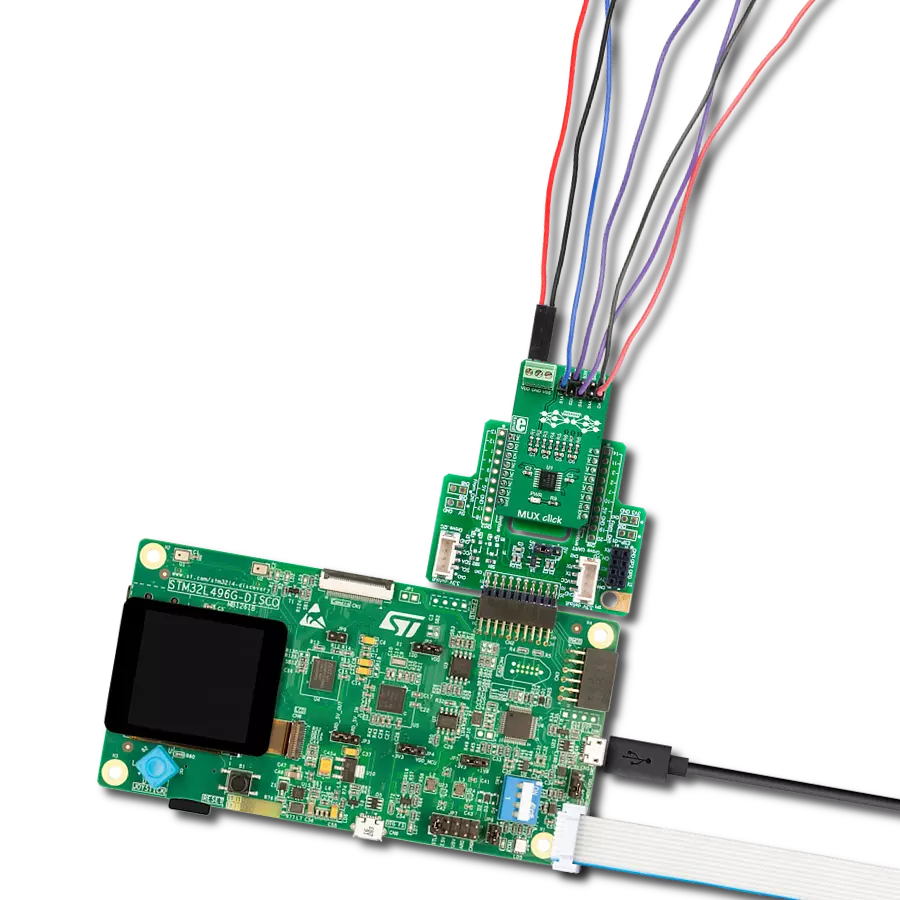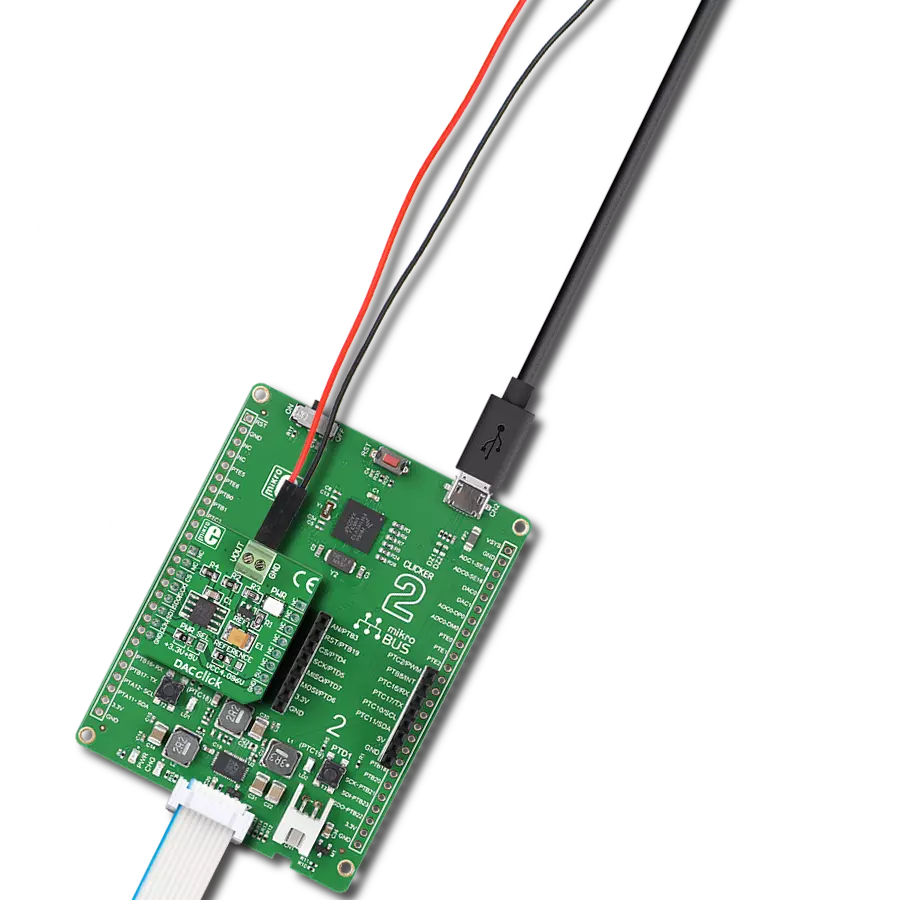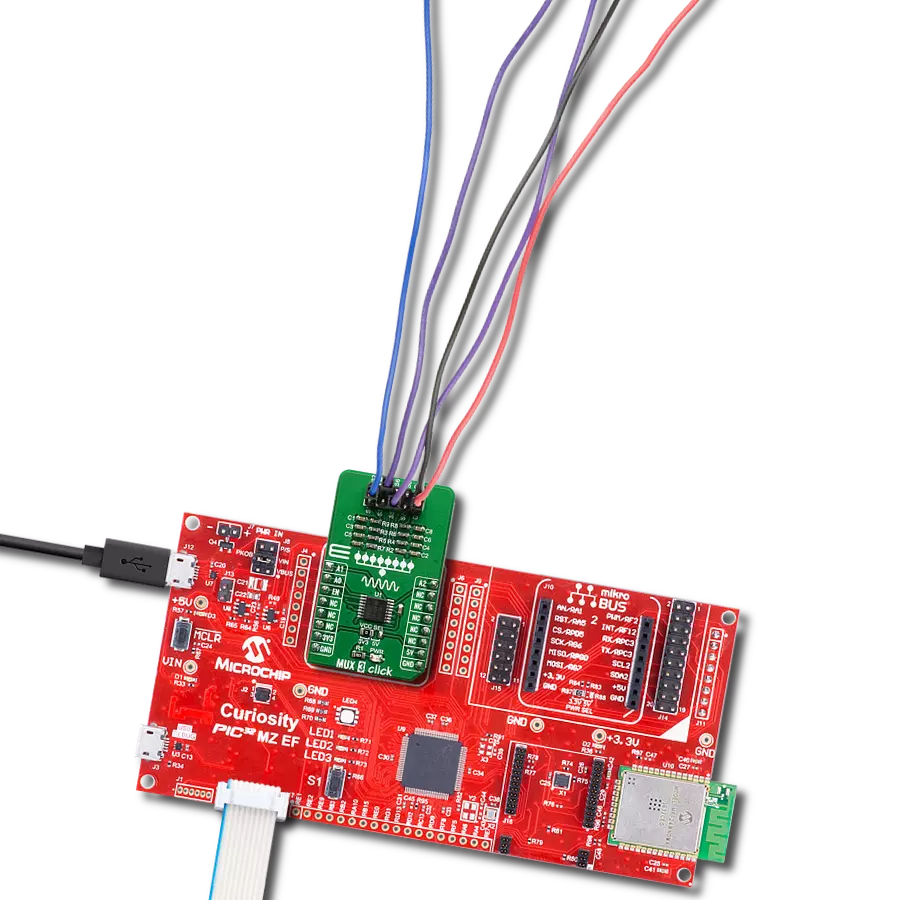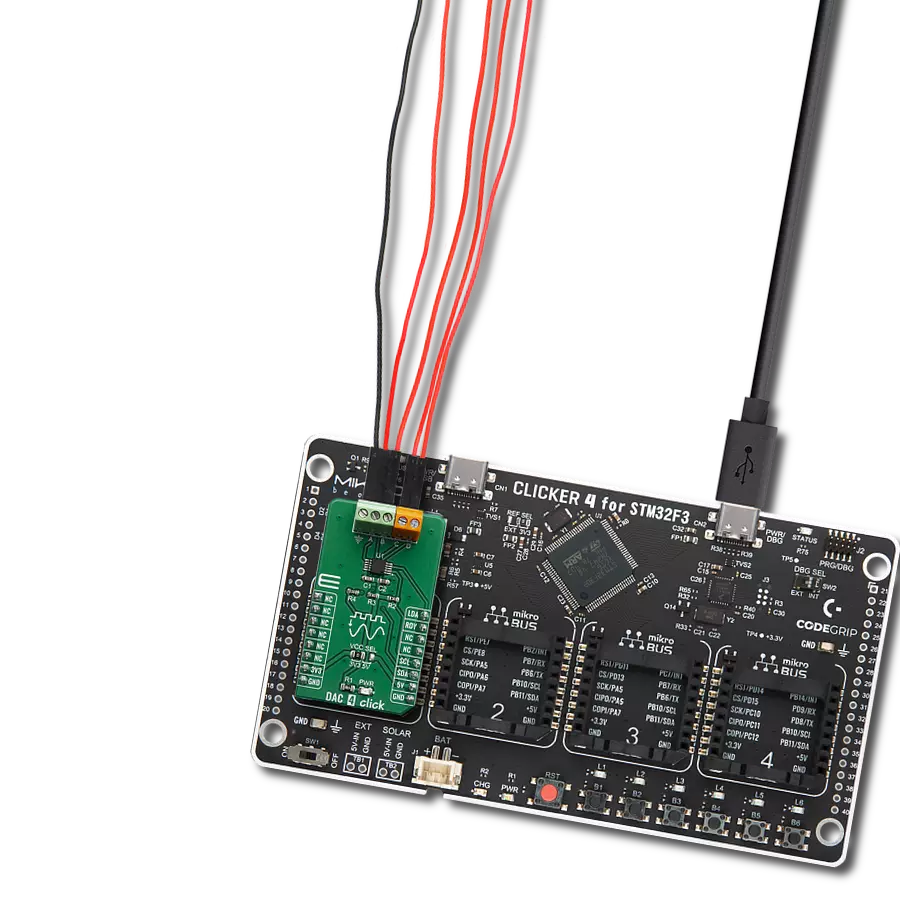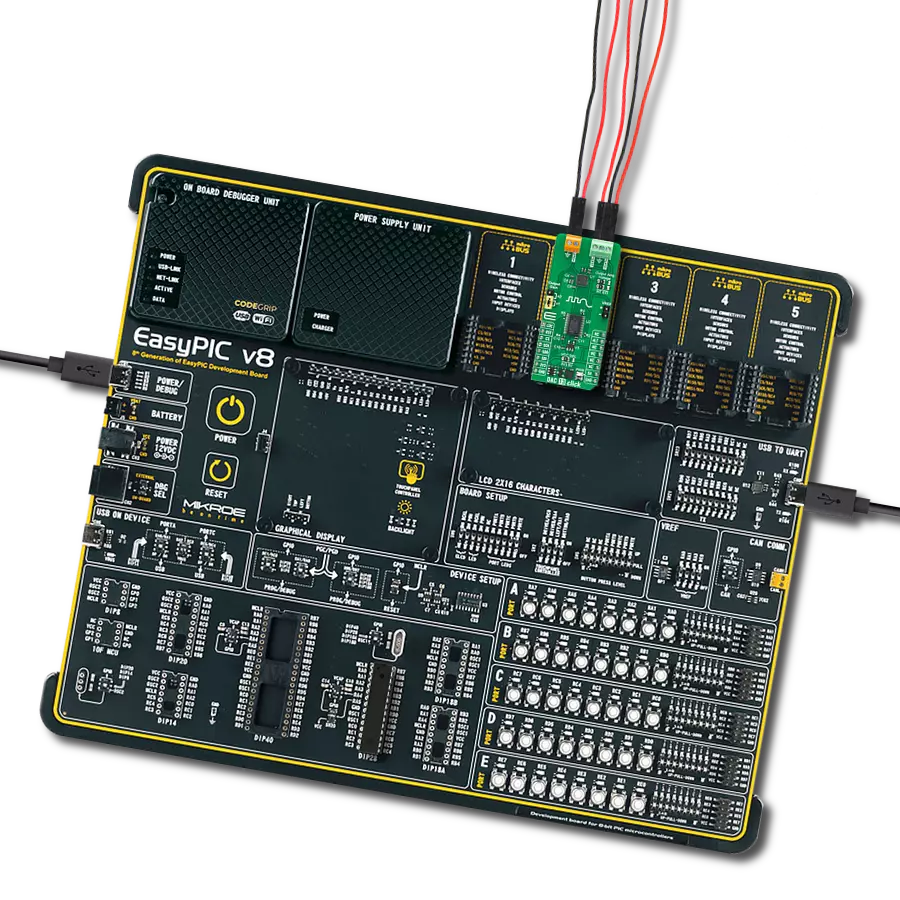Designed for precision, it transforms digital insights into analog realities, enabling seamless communication and decision-making
A
A
Hardware Overview
How does it work?
DAC 4 Click is based on the MCP4728, a quad, 12-bit voltage output Digital-to-Analog converter (DAC) with nonvolatile memory (EEPROM) from Microchip. Its onboard precision output amplifier allows it to achieve rail-to-rail analog output swing. The DAC input codes, device configuration bits, and I2C address bits are programmable to the nonvolatile memory (EEPROM) using I2C serial interface commands. The nonvolatile memory feature enables the DAC device to hold the DAC input codes during power-off time, allowing the DAC outputs to be available immediately after power-up with the saved settings. The MCP4728 device has a high-precision internal voltage reference (VREF = 2.048V). The user can select the internal reference, or an external reference may be used (VDD) for each channel individually. This
gives the ADC 4-click good flexibility for use in various applications. Each channel can be operated individually in Normal mode or Power-Down mode by setting the configuration register bits. In Power-Down mode, most of the internal circuits in the powered-down channel are turned off for power savings, and the output amplifier can be configured to present a known low, medium, or high resistance output load. This device also includes a Power-on Reset (POR) circuit to ensure reliable power-up and an onboard charge pump for the EEPROM programming voltage. The MCP4728 has four output pins routed to the output terminal blocks (TB1 and TB2). The output range of the DAC is 0 V to VREF or 0 V to 2×V REF. The communication with the main MCU is established over a two-wire I2C compatible serial
interface, with standard (100 kHz), fast (400 kHz), or high speed (3.4 MHz) modes supported. The I2C lines (SCL and SDA) are routed to the dedicated mikroBUS™pins. The LDA pin is a multipurpose GPIO: It can be used as Synchronization input or for the device I2C address selection. RDY pin can also optionally be used to monitor the status of EEPROM programming activity. This Click board™ can operate with either 3.3V or 5V logic voltage levels selected via the VCC SEL jumper. This way, both 3.3V and 5V capable MCUs can use the communication lines properly. Also, this Click board™ comes equipped with a library containing easy-to-use functions and an example code that can be used, as a reference, for further development.
Features overview
Development board
Nucleo-144 with STM32F413ZH MCU board offers an accessible and adaptable avenue for users to explore new ideas and construct prototypes. It allows users to tailor their experience by selecting from a range of performance and power consumption features offered by the STM32 microcontroller. With compatible boards, the
internal or external SMPS dramatically decreases power usage in Run mode. Including the ST Zio connector, expanding ARDUINO Uno V3 connectivity, and ST morpho headers facilitate easy expansion of the Nucleo open development platform. The integrated ST-LINK debugger/programmer enhances convenience by
eliminating the need for a separate probe. Moreover, the board is accompanied by comprehensive free software libraries and examples within the STM32Cube MCU Package, further enhancing its utility and value.
Microcontroller Overview
MCU Card / MCU
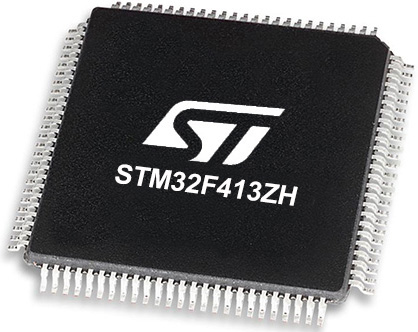
Architecture
ARM Cortex-M4
MCU Memory (KB)
1536
Silicon Vendor
STMicroelectronics
Pin count
144
RAM (Bytes)
327680
You complete me!
Accessories
Click Shield for Nucleo-144 comes equipped with four mikroBUS™ sockets, with one in the form of a Shuttle connector, allowing all the Click board™ devices to be interfaced with the STM32 Nucleo-144 board with no effort. This way, MIKROE allows its users to add any functionality from our ever-growing range of Click boards™, such as WiFi, GSM, GPS, Bluetooth, ZigBee, environmental sensors, LEDs, speech recognition, motor control, movement sensors, and many more. Featuring an ARM Cortex-M microcontroller, 144 pins, and Arduino™ compatibility, the STM32 Nucleo-144 board offers limitless possibilities for prototyping and creating diverse applications. These boards are controlled and powered conveniently through a USB connection to program and efficiently debug the Nucleo-144 board out of the box, with an additional USB cable connected to the USB mini port on the board. Simplify your project development with the integrated ST-Link debugger and unleash creativity using the extensive I/O options and expansion capabilities. This Click Shield also has several switches that perform functions such as selecting the logic levels of analog signals on mikroBUS™ sockets and selecting logic voltage levels of the mikroBUS™ sockets themselves. Besides, the user is offered the possibility of using any Click board™ with the help of existing bidirectional level-shifting voltage translators, regardless of whether the Click board™ operates at a 3.3V or 5V logic voltage level. Once you connect the STM32 Nucleo-144 board with our Click Shield for Nucleo-144, you can access hundreds of Click boards™, working with 3.3V or 5V logic voltage levels.
Used MCU Pins
mikroBUS™ mapper
Take a closer look
Click board™ Schematic

Step by step
Project assembly
Software Support
Library Description
This library contains API for DAC 4 Click driver.
Key functions:
dac4_voltage_reference_set- Setting channel voltage reference valuesdac4_gain_set- Writing channel gain valuesdac4_data_report- Reading channel data and forming reports
Open Source
Code example
The complete application code and a ready-to-use project are available through the NECTO Studio Package Manager for direct installation in the NECTO Studio. The application code can also be found on the MIKROE GitHub account.
/*!
* \file
* \brief Dac4 Click example
*
* # Description
* This application enables usage of digital to analog converter.
*
* The demo application is composed of two sections :
*
* ## Application Init
* Initializes I2C driver, executes general call reset and wake up commands.
*
* ## Application Task
* Changes the output voltage of channels every 3 seconds, and displays
* the channels status on the USB UART.
*
* \author MikroE Team
*
*/
// ------------------------------------------------------------------- INCLUDES
#include "board.h"
#include "log.h"
#include "dac4.h"
// ------------------------------------------------------------------ VARIABLES
static dac4_t dac4;
static log_t logger;
// ------------------------------------------------------- ADDITIONAL FUNCTIONS
void dac4_log_report ( uint8_t channel_no )
{
dac4_channel_setting_t dac4_channel_buffer[ 8 ];
dac4_data_report ( &dac4, dac4_channel_buffer );
channel_no *= 2;
log_printf( &logger, "--- Power ON bit: " );
switch ( dac4_channel_buffer[ channel_no ].por_bit )
{
case 0:
{
log_printf( &logger,"Power OFF\r\n" );
break;
}
case 1:
{
log_printf( &logger, "Power ON\r\n" );
break;
}
default :
{
break;
}
}
log_printf( &logger, "--- V reference : " );
switch ( dac4_channel_buffer[ channel_no ].voltage_reference )
{
case DAC4_VREF_EXTERNAL:
{
log_printf( &logger, "External\r\n" );
break;
}
case DAC4_VREF_INTERNAL:
{
log_printf( &logger, "Internal\r\n" );
break;
}
default :
{
break;
}
}
log_printf( &logger, "--- Power mode : " );
switch ( dac4_channel_buffer[ channel_no ].power_mode )
{
case DAC4_MODE_NORMAL:
{
log_printf( &logger, "Normal\r\n" );
break;
}
case DAC4_MODE_1kOhm:
{
log_printf( &logger, "1 kOhm\r\n" );
break;
}
case DAC4_MODE_100kOhm:
{
log_printf( &logger, "100 kOhm\r\n" );
break;
}
case DAC4_MODE_500kOhm:
{
log_printf( &logger, "500 kOhm\r\n" );
break;
}
default :
{
break;
}
}
log_printf( &logger, "--- Gain value : " );
switch ( dac4_channel_buffer[ channel_no ].gain_value )
{
case DAC4_MODE_NORMAL:
{
log_printf( &logger, "1x Gain\r\n" );
break;
}
case DAC4_MODE_1kOhm:
{
log_printf( &logger, "2x Gain\r\n" );
break;
}
default :
{
break;
}
}
log_printf( &logger, "--- DAC input data : %d [0-4095]\r\n", dac4_channel_buffer[ channel_no ].dac_input_data );
log_printf( &logger, "-------------------------------------\r\n" );
}
void dac4_set_output ( uint8_t channel_set )
{
dac4_channel_setting_t dac4_channel_x;
static uint16_t aux_dac_input_data = 0;
dac4_channel_x.channel_select = channel_set;
dac4_channel_x.udac_bit = DAC4_UPDATE;
dac4_channel_x.voltage_reference = DAC4_VREF_EXTERNAL;
dac4_channel_x.power_mode = DAC4_MODE_NORMAL;
dac4_channel_x.gain_value = DAC4_GAIN_x1;
dac4_channel_x.dac_input_data = aux_dac_input_data;
if ( 0 != dac4_single_write( &dac4, &dac4_channel_x ) )
{
log_printf( &logger, "--- Fatal ERROR !!! \r\n" );
}
else
{
log_printf( &logger, "------------------------------------- \r\n" );
log_printf( &logger, "--- Output setup done \r\n" );
log_printf( &logger, "------------------------------------- \r\n" );
aux_dac_input_data += 500;
if ( aux_dac_input_data > 4095 )
{
aux_dac_input_data = 0;
}
}
}
void dac4_channel_report ( )
{
log_printf( &logger, "\r\n -----> Channel A \r\n" );
dac4_set_output( DAC4_CHANNEL_A );
dac4_log_report( 0 );
Delay_ms ( 1000 );
Delay_ms ( 1000 );
Delay_ms ( 1000 );
log_printf( &logger, "\r\n -----> Channel B \r\n" );
dac4_set_output( DAC4_CHANNEL_B );
dac4_log_report( 1 );
Delay_ms ( 1000 );
Delay_ms ( 1000 );
Delay_ms ( 1000 );
log_printf( &logger, "\r\n -----> Channel C \r\n" );
dac4_set_output( DAC4_CHANNEL_C );
dac4_log_report( 2 );
Delay_ms ( 1000 );
Delay_ms ( 1000 );
Delay_ms ( 1000 );
log_printf( &logger, "\r\n -----> Channel D \r\n" );
dac4_set_output( DAC4_CHANNEL_D );
dac4_log_report( 3 );
Delay_ms ( 1000 );
Delay_ms ( 1000 );
Delay_ms ( 1000 );
}
// ------------------------------------------------------ APPLICATION FUNCTIONS
void application_init ( void )
{
log_cfg_t log_cfg;
dac4_cfg_t cfg;
/**
* Logger initialization.
* Default baud rate: 115200
* Default log level: LOG_LEVEL_DEBUG
* @note If USB_UART_RX and USB_UART_TX
* are defined as HAL_PIN_NC, you will
* need to define them manually for log to work.
* See @b LOG_MAP_USB_UART macro definition for detailed explanation.
*/
LOG_MAP_USB_UART( log_cfg );
log_init( &logger, &log_cfg );
log_info( &logger, "---- Application Init ----" );
// Click initialization.
dac4_cfg_setup( &cfg );
DAC4_MAP_MIKROBUS( cfg, MIKROBUS_1 );
dac4_init( &dac4, &cfg );
log_info( &logger, "---- Application ----" );
Delay_ms ( 500 );
dac4_general_call_reset( &dac4 );
Delay_ms ( 500 );
dac4_general_call_wake_up( &dac4 );
Delay_ms ( 500 );
log_printf( &logger, "--- App init done \r\n \r\n" );
}
void application_task ( void )
{
dac4_channel_report( );
}
int main ( void )
{
/* Do not remove this line or clock might not be set correctly. */
#ifdef PREINIT_SUPPORTED
preinit();
#endif
application_init( );
for ( ; ; )
{
application_task( );
}
return 0;
}
// ------------------------------------------------------------------------ END
Additional Support
Resources
Category:DAC
